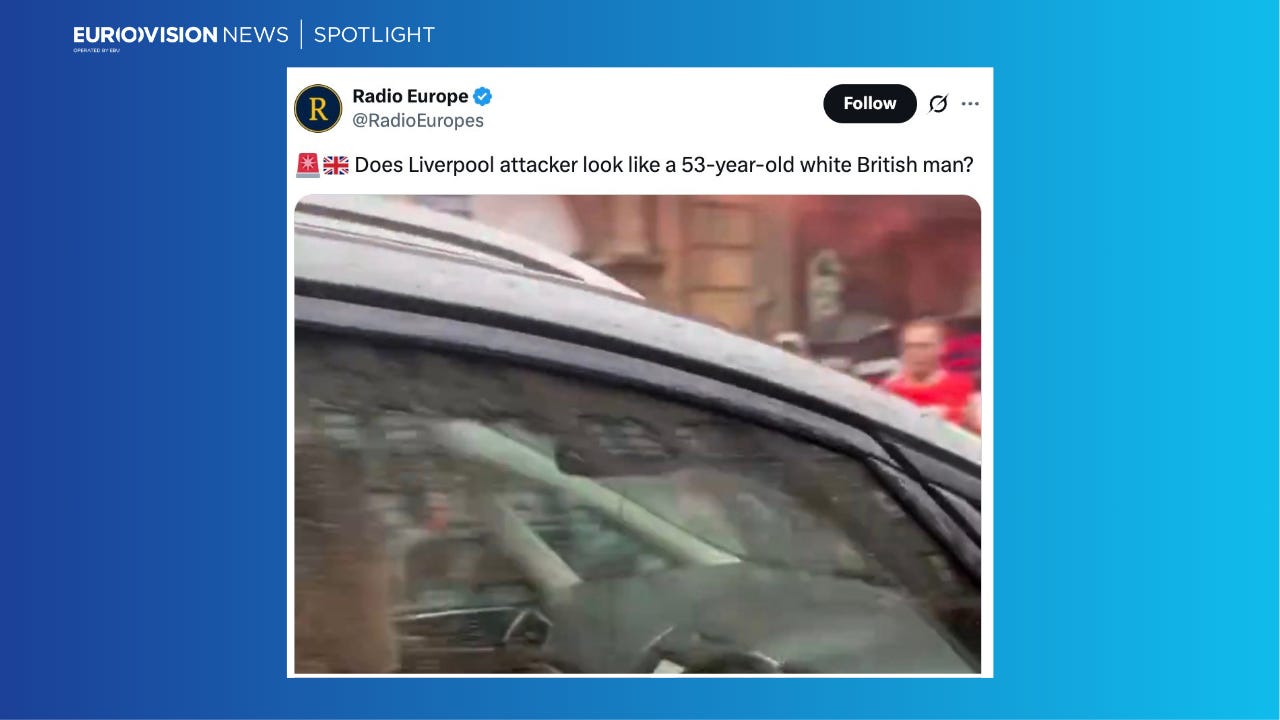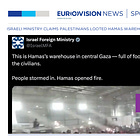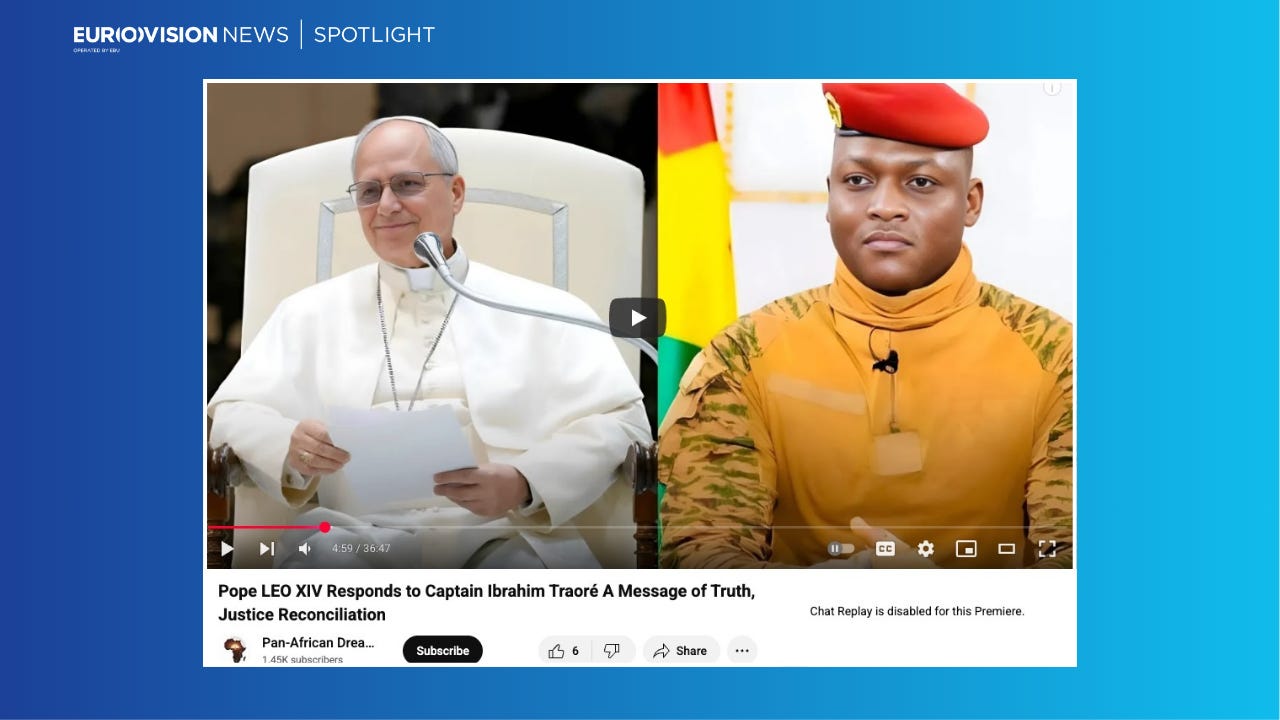Fact-Check Dispatch: Wrong man named in Liverpool parade incident, Gaza aid misinformation, and AI targets Pope Leo
Issue 22 of the Fact-Check Dispatch
A terrifying incident in Liverpool led to the injury of at least 70 people — but minutes after the ordeal, anti-immigrant activists were taking advantage of the situation with unfounded claims about the perpetrator.
In Gaza, the story of the week was the much-needed aid that finally made it in, and the chaos that surrounded some of its distribution. There, a swirl of misinformation surrounded a controversial aid delivery programme, and even official sources were spreading fake news about chaotic scenes at a flour-filled warehouse.
And the new pope, who has named AI as one of the biggest challenges to humanity, was himself ripped off in videos addressing world leaders.
Here’s our fact-check dispatch.
Conspiracy theorists milk Liverpool parade incident
A major incident at a victory parade for Liverpool FC in Merseyside, which saw a driver go through a crowd injuring more than 70 people, shocked Britain last week.
And at a time of heightened racial tensions and online right-wing discourse, any incident like this immediately prompts widespread speculation that the perpetrator was either an immigrant, a Muslim, an asylum seeker, or otherwise non-white and non-British.
The UK has been here before. After the Southport knife attack in 2024, which saw a teenager stabbing three children to death while they were attending a Taylor Swift-themed dance class, far-right activists flooded social media with misinformation which ultimately ended in riots, an attack on a local mosque, and missiles thrown at police.
In the case of Southport, it took several days for the identity of the attacker to be released. The flow of information by authorities was complicated by the fact that the attacker was himself a minor, limiting the amount of information that could be released before he was charged. The information vacuum in the days between the attack and the official naming of the suspect created the perfect environment for rampant conspiracy theories and the spreading of incorrect names, as reported widely at the time.
The Liverpool incident started out similarly. Right-wing activists immediately jumped on the incident as evidence of a criminal immigrant element in the community. But in an unusual turn of events, the British police released details about the suspect’s identity at unprecedented speed; he was a white British male aged 53, they announced within two hours of the incident.
The local police’s decision to release information early in a bid to stem misinformation was praised by the country’s independent watchdog on terror legislation, Jonathan Hall KC, who had previously warned that the failure to do the same in Southport had fanned the riots.
Nevertheless, misinformation still swirled in the hours after the Liverpool incident. For SVT Verifierar, Henrik Sköld and Simon Krona write about how posts circulated saying: “First image of Liverpool attacker. Attacker is thought to be foreign.” The account, @RadioEuropes, has since deleted the post, presumably after police released the information about the suspect. However, they later followed up with “Do you believe that the Liverpool attacker is a 53-year-old white British man?” and “Does Liverpool attacker look like a 53-year-old white British man?”.
In other posts, an image of a completely different man were circulating with captions like: “Young, and definitely not white. Coverup already running.” Sköld and Krona write: “On X, posts with this text have been viewed over a million times. But the man in the picture is not the one who drove the car into the crowds.”
The verification experts at SVT downloaded a moving clip from social media showing the wrongly accused man. Explaining how they analysed it, they write: “From that clip, we extracted several screenshots showing different facial expressions and angles of the man's face. Using facial recognition software, we were able to find a photo of a person resembling the man, published on a website belonging to a cleaning company outside Birmingham.”
Using Amazon Rekognition, the team compared faces and assessed the degree of similarity between them. “We were able to determine that the man who was wrongly accused was very likely the same person who appeared on the cleaning company's website … Based on this, we were able to identify the person, and assess that he did not look to be 53 years old, but rather much younger.”
As evidenced by the situation in Southport almost a year earlier, false IDs and race-based assumptions can have a hugely damaging effect on public safety, and can even spark riots. This further highlights the importance of both this type of verification work, and of a swift and transparent reaction by public authorities.
Misinformation swirls about Gaza aid crisis
The dire shortage of aid in the Gaza Strip came to a head during the week when the almost three-month-long Israeli blockade on goods finally ended.
A controversial U.S. and Israel-backed plan to deliver aid into the enclave via the Gaza Humanitarian Foundation failed immediately when desperate crowds rushed at the first distribution site it opened in southern Gaza.
Before that incident, it had not actually been clear whether the programme had begun distributing aid, after it said the day before that it had started handing out food. For Eurovision News Spotlight, Jenny Hauser looked at the evidence and spoke to people on the ground, ultimately confirming that the site was indeed operational near Rafah.
Meanwhile, the Israeli Ministry of Foreign Affairs claimed that Palestinians looted a Hamas warehouse storing flour, accusing the militant group of hoarding food. The official ministry account posted a video of the chaos at the warehouse, saying in the caption: “This is Hamas's warehouse in central Gaza — full of food, kept away from the civilians. People stormed in. Hamas opened fire.”
The Gaza government, meanwhile, said that the warehouse in Deir al-Balah was a United Nations World Food Programme property, adding that it was a “regrettable incident stemming from the catastrophic humanitarian conditions endured by the population due to the intensified Israeli siege and its systematic starvation policy”.
The World Food Programme confirmed it was operating the warehouse — not Hamas, as the Israeli Foreign Ministry claimed. The story of it being overrun by desperate people in search of food was true, Hauser writes.
The story about Gaza overlaps with a consumer story in the West, particularly for those in the pro-Palestine community who are keen to observe a boycott on Israeli goods.
However, it’s not always easy to know whether a product has come from Israel, as readers of VerificaRTVE pointed out in messages requesting an explainer. Paula Peña writes about a long-running theory that the number at the beginning of a product’s barcode indicates its origin, and that Israeli goods are barcoded with a number beginning 729. There were further claims that due to the boycott, Israel changed the number to 871.

Despite the detail in these claims, all is not as it seems, Peña writes. “This numbering does not indicate the origin of an item or its manufacturer, as explained by the [Spanish] Association of Manufacturers and Distributors (AECOC) in 2023. 871 is a code associated with the Netherlands, and Israel has not changed its barcode to avoid the boycott of its products due to the conflict in Gaza.”
In fact, the prefix identifies the GS1 member organisation to which the company is registered. The barcode prefix 729 is indeed associated with Israel, but does not mean an item was produced in that country or even that the company is based in Israel or of Israeli origin. Companies can choose to barcode their products through any of the GS1 member organisations, so it may just mean that the company registered through the Israeli member entity.
The clarification on what barcode numbers mean is valuable for both those observing boycotts as well as businesses that may be unfairly targeted by such actions.
Pope Leo targeted by misinformation
Pope Leo XIV is only a few weeks into his papacy, but even he hasn’t escaped being a target for widespread misinformation, including as the subject of AI-generated content.
For Deutsche Welle, Sarah Steffen and Kathrin Wesolowski looked into a number of examples, such as a claim that the pope responded to a letter by the Burkina Faso junta leader Ibrahim Traoré. The pope says in a video: “I have read your words not once, but many times (…), because in your voice I have heard not merely the anger of a president, but the righteous cry of a continent long wounded by the dual blades of neglect and exploitation.”
The 36-minute video is a complete fabrication. Steffen and Wesolowski found the real papal audience it drew from through a reverse image search. “The video used a morphing technique to make the Pope's lip movements line up with the AI-generated audio recording,” they write.
The video even drew comment from the Vatican’s official media portal. It’s unusual for the Vatican to put out a debunk article — this is the first under a new ‘Fake News’ tag on its website — but this is a new papacy. The newly inaugurated Pope Leo has made Artificial Intelligence one of his key priorities, identifying it as one of the big challenges facing humanity. He even referred to AI when he explained his choice of the name Leo. (The previous Pope Leo became known over 120 years ago for his defence of labour rights and criticism of free market capitalism amid the industrial age.)
Steffen and Wesolowski also explained how they fact-checked several other instances of false material, including a video purporting to show him criticising Donald Trump, which is manipulated, and his supposed ignoring of a Pride rainbow flag, which is actually an Italian peace flag.









